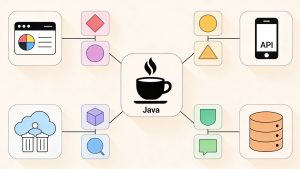
The world of web development has seen many frameworks come and go, but only a few have managed to change how developers think about building applications. Remix is one of them.
Remix is a modern fullstack web framework built on top of React that focuses on performance, developer experience, and progressive enhancement. Unlike traditional SPAs (Single Page Applications), Remix is designed to make the most out of the web platform, leveraging server-side rendering (SSR), nested routing, data loading APIs, and built-in error handling.
What makes Remix stand out is its commitment to using the web as it was meant to be used—fast, accessible, and resilient. Instead of overloading the client with JavaScript, Remix optimizes for progressive enhancement, ensuring apps work even in limited environments.
Whether you’re building an e-commerce platform, a SaaS product, or a personal blog, Remix gives you the tools to create scalable, performant, and resilient applications.
Key Features of Remix Framework

Remix comes with a rich set of features out of the box. Some of the most notable include:
- Nested Routes – Routes map directly to your UI hierarchy. Each route can fetch its own data and render independently.
- Data Loading APIs – With loader functions, Remix makes fetching data at the route level straightforward and efficient.
- Actions for Mutations – Use action functions to handle POST, PUT, DELETE, and other mutations seamlessly.
- Built-In Error Boundaries – Every route can have its own error boundary, making apps more resilient.
- Server-Side Rendering (SSR) – Remix prioritizes server-rendered HTML for speed and SEO.
- Optimized Performance – Leveraging browser caching, HTTP semantics, and streaming.
- Progressive Enhancement – Apps continue to work even if JavaScript fails or is disabled.
Example: Nested Routes with Data Loading
// app/routes/posts.tsx
import { json } from "@remix-run/node";
import { useLoaderData } from "@remix-run/react";
export const loader = async () => {
const posts = await fetch("https://jsonplaceholder.typicode.com/posts").then(res => res.json());
return json(posts);
};
export default function Posts() {
const posts = useLoaderData<typeof loader>();
return (
<div>
<h1>All Posts</h1>
<ul>
{posts.slice(0, 5).map((post: any) => (
<li key={post.id}>{post.title}</li>
))}
</ul>
</div>
);
}This code example shows how Remix loads data per route without over-fetching or duplicating logic.
Remix Architecture & How It Works
Remix apps are structured around file-based routing. Each file inside app/routes/ corresponds to a URL. The architecture embraces nested routing, meaning that child routes render inside parent layouts.
Here’s how Remix works at a high level:
- Routing System – Routes are defined as files. For example, app/routes/dashboard.tsx maps to /dashboard.
- Loaders – Functions that run on the server to fetch data for a route.
- Actions – Functions to handle form submissions and mutations.
- Error Boundaries – Catch errors at the route level.
- Client & Server Integration – Remix compiles code that runs seamlessly on both client and server.
Architecture Flow
User requests a page -Remix server calls the loader- Data is fetched -Server sends back HTML with data embedded -React hydrates the page on the client.
This makes Remix fast, SEO-friendly, and resilient.
Benefits of Using Remix
- Performance-First – Server rendering + HTTP caching ensures fast load times.
- SEO-Friendly – Pages are rendered with actual HTML, improving crawlability.
- Developer Experience – Simple API, file-based routing, and built-in error handling.
- Scalability – Works for small apps and enterprise-level projects.
- Progressive Enhancement – Users can still access core functionality without JS.
- Fullstack Capabilities – Handle both frontend and backend logic in one project.
Challenges & Limitations
While Remix is powerful, it’s not without trade-offs:
- Learning Curve – Developers familiar with pure React/Next.js may need time to adapt.
- Hosting Considerations – Requires Node.js runtime, though it supports deployment to serverless environments like Vercel, Fly.io, or Cloudflare Workers.
- Community Size – Smaller compared to React or Next.js, though growing rapidly.
- Opinionated Approach – Remix enforces certain patterns which might feel restrictive.
Remix vs Other Frameworks
How does Remix compare with other popular frameworks?
- Remix vs Next.js – Next.js is more mature with a larger ecosystem. Remix, however, offers better nested routing, built-in data loading, and progressive enhancement.
- Remix vs Express – Express is backend-only. Remix integrates frontend + backend seamlessly.
- Remix vs Gatsby – Gatsby focuses on static site generation (SSG), while Remix focuses on SSR + progressive enhancement.
Example: Data Mutation with Remix
// app/routes/contact.tsx
import { Form, useActionData } from "@remix-run/react";
export const action = async ({ request }: { request: Request }) => {
const formData = await request.formData();
const message = formData.get("message");
return { success: true, message };
};
export default function Contact() {
const actionData = useActionData<typeof action>();
return (
<div>
<h1>Contact Us</h1>
<Form method="post">
<textarea name="message" required />
<button type="submit">Send</button>
</Form>
{actionData?.success && <p>Message sent: {actionData.message}</p>}
</div>
);
}This example highlights how Remix simplifies form handling and mutations.
Common Use Cases for Remix
- E-commerce Platforms – SEO, performance, and routing make Remix ideal for online stores.
- Content Platforms – Blogs, news sites, and knowledge bases.
- SaaS Applications – Fullstack capabilities + user authentication flows.
- Internal Dashboards – Nested routes and data loaders make complex UIs easier.
- Collaborative Tools – Real-time apps that benefit from Remix’s server-client balance.
Getting Started with Remix
Getting started is simple:
Step 1: Install Remix
npx create-remix@latestYou’ll be prompted to choose a deployment target (Node, Vercel, Cloudflare, etc.).
Step 2: Run the Dev Server
npm run devStep 3: Create Your First Route
// app/routes/index.tsx
export default function Index() {
return <h1>Welcome to Remix!</h1>;
}And that’s it. You have your first Remix app running.
Best Practices for Remix Development
- Leverage Loaders & Actions – Fetch and mutate data at the route level.
- Use Error Boundaries – Define route-specific error boundaries for better UX.
- Optimize for Caching – Use HTTP caching headers effectively.
- Structure Routes Thoughtfully – Keep files modular and organized.
- Progressive Enhancement – Design apps to work without relying too heavily on JS.
- Deploy Wisely – Choose deployment platforms (like Vercel, Fly.io, or Cloudflare Workers) that match your scaling needs.
Conclusion
Remix represents a paradigm shift in web development away from bloated SPAs and toward apps that truly embrace the web platform. Its architecture, rooted in nested routing, SSR, progressive enhancement, and built-in data APIs, makes it an excellent choice for developers who want both performance and scalability.
While it comes with a learning curve, the benefits in speed, developer experience, and SEO far outweigh the limitations. Whether you’re building a small blog or a large SaaS platform, Remix equips you with everything you need to create modern, resilient web applications.
For developers in 2025, learning Remix is not just about staying relevant but also about mastering a framework that puts the user experience and web fundamentals at the center of application design.



